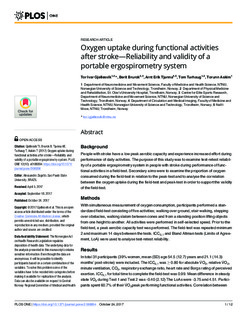| dc.contributor.author | Gjellesvik, Tor Ivar | |
| dc.contributor.author | Brurok, Berit | |
| dc.contributor.author | Tjønna, Arnt Erik | |
| dc.contributor.author | Tørhaug, Tom | |
| dc.contributor.author | Askim, Torunn | |
| dc.date.accessioned | 2017-12-04T11:45:23Z | |
| dc.date.available | 2017-12-04T11:45:23Z | |
| dc.date.created | 2017-11-17T11:25:48Z | |
| dc.date.issued | 2017 | |
| dc.identifier.citation | PLoS ONE. 2017, 12 (10): e0186894. | nb_NO |
| dc.identifier.issn | 1932-6203 | |
| dc.identifier.uri | http://hdl.handle.net/11250/2468993 | |
| dc.description.abstract | Background
People with stroke have a low peak aerobic capacity and experience increased effort during performance of daily activities. The purpose of this study was to examine test-retest reliability of a portable ergospirometry system in people with stroke during performance of functional activities in a field-test. Secondary aims were to examine the proportion of oxygen consumed during the field-test in relation to the peak-test and to analyse the correlation between the oxygen uptake during the field-test and peak-test in order to support the validity of the field-test.
Methods
With simultaneous measurement of oxygen consumption, participants performed a standardized field-test consisting of five activities; walking over ground, stair walking, stepping over obstacles, walking slalom between cones and from a standing position lifting objects from one height to another. All activities were performed in self-selected speed. Prior to the field-test, a peak aerobic capacity test was performed. The field-test was repeated minimum 2 and maximum 14 days between the tests. ICC2,1 and Bland Altman tests (Limits of Agreement, LoA) were used to analyse test-retest reliability.
Results
In total 31 participants (39% women, mean (SD) age 54.5 (12.7) years and 21.1 (14.3) months’ post-stroke) were included. The ICC2,1 was ≥ 0.80 for absolute V̇O2, relative V̇O2, minute ventilation, CO2, respiratory exchange ratio, heart rate and Borgs rating of perceived exertion. ICC2,1 for total time to complete the field-test was 0.99. Mean difference in steady state V̇O2 during Test 1 and Test 2 was -0.40 (2.12) The LoAs were -3.75 and 4.51. Participants spent 60.7% of their V̇O2peak performing functional activities. Correlation between field-test and peak-test was 0.689, p = 0.001 for absolute and 0.733, p = 0.001 for relative V̇O2.
Conclusions
This study presents first evidence on reliability of oxygen uptake during performance of functional activities after stroke, showing very good test-retest reliability. The secondary analysis showed that the amount of energy spent during the field-test relative to the peak-test was high and the correlation between the two test was good, supporting the validity of this method. | nb_NO |
| dc.language.iso | eng | nb_NO |
| dc.publisher | Public Library of Science | nb_NO |
| dc.rights | Navngivelse 4.0 Internasjonal | * |
| dc.rights.uri | http://creativecommons.org/licenses/by/4.0/deed.no | * |
| dc.title | Oxygen uptake during functional activities after stroke - Reliability and validity of a portable ergospirometry system | nb_NO |
| dc.type | Journal article | nb_NO |
| dc.type | Peer reviewed | nb_NO |
| dc.description.version | publishedVersion | nb_NO |
| dc.source.volume | 12 | nb_NO |
| dc.source.journal | PLoS ONE | nb_NO |
| dc.source.issue | 10 | nb_NO |
| dc.identifier.doi | 10.1371/journal.pone.0186894 | |
| dc.identifier.cristin | 1515219 | |
| dc.description.localcode | © 2017 Gjellesvik et al. This is an open access article distributed under the terms of the Creative Commons Attribution License, which permits unrestricted use, distribution, and reproduction in any medium, provided the original author and source are credited. | nb_NO |
| cristin.unitcode | 194,65,30,0 | |
| cristin.unitcode | 194,65,25,0 | |
| cristin.unitname | Institutt for nevromedisin og bevegelsesvitenskap | |
| cristin.unitname | Institutt for sirkulasjon og bildediagnostikk | |
| cristin.ispublished | true | |
| cristin.fulltext | original | |
| cristin.qualitycode | 1 | |

